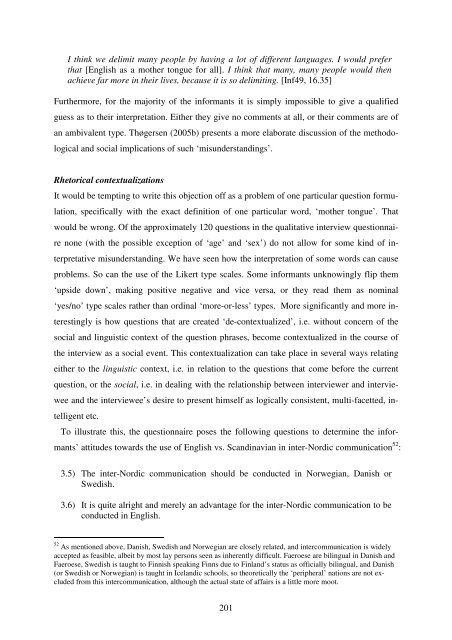Hør dog hvad de siger - Note-to-Self: Trials & Errors
Hør dog hvad de siger - Note-to-Self: Trials & Errors
Hør dog hvad de siger - Note-to-Self: Trials & Errors
Create successful ePaper yourself
Turn your PDF publications into a flip-book with our unique Google optimized e-Paper software.
I think we <strong>de</strong>limit many people by having a lot of different languages. I would prefer<br />
that [English as a mother <strong>to</strong>ngue for all]. I think that many, many people would then<br />
achieve far more in their lives, because it is so <strong>de</strong>limiting. [Inf49, 16.35]<br />
Furthermore, for the majority of the informants it is simply impossible <strong>to</strong> give a qualified<br />
guess as <strong>to</strong> their interpretation. Either they give no comments at all, or their comments are of<br />
an ambivalent type. Thøgersen (2005b) presents a more elaborate discussion of the methodo-<br />
logical and social implications of such ‘misun<strong>de</strong>rstandings’.<br />
Rhe<strong>to</strong>rical contextualizations<br />
It would be tempting <strong>to</strong> write this objection off as a problem of one particular question formu-<br />
lation, specifically with the exact <strong>de</strong>finition of one particular word, ‘mother <strong>to</strong>ngue’. That<br />
would be wrong. Of the approximately 120 questions in the qualitative interview questionnai-<br />
re none (with the possible exception of ‘age’ and ‘sex’) do not allow for some kind of in-<br />
terpretative misun<strong>de</strong>rstanding. We have seen how the interpretation of some words can cause<br />
problems. So can the use of the Likert type scales. Some informants unknowingly flip them<br />
‘upsi<strong>de</strong> down’, making positive negative and vice versa, or they read them as nominal<br />
‘yes/no’ type scales rather than ordinal ‘more-or-less’ types. More significantly and more in-<br />
terestingly is how questions that are created ‘<strong>de</strong>-contextualized’, i.e. without concern of the<br />
social and linguistic context of the question phrases, become contextualized in the course of<br />
the interview as a social event. This contextualization can take place in several ways relating<br />
either <strong>to</strong> the linguistic context, i.e. in relation <strong>to</strong> the questions that come before the current<br />
question, or the social, i.e. in <strong>de</strong>aling with the relationship between interviewer and intervie-<br />
wee and the interviewee’s <strong>de</strong>sire <strong>to</strong> present himself as logically consistent, multi-facetted, in-<br />
telligent etc.<br />
To illustrate this, the questionnaire poses the following questions <strong>to</strong> <strong>de</strong>termine the infor-<br />
mants’ attitu<strong>de</strong>s <strong>to</strong>wards the use of English vs. Scandinavian in inter-Nordic communication 52 :<br />
3.5) The inter-Nordic communication should be conducted in Norwegian, Danish or<br />
Swedish.<br />
3.6) It is quite alright and merely an advantage for the inter-Nordic communication <strong>to</strong> be<br />
conducted in English.<br />
52 As mentioned above, Danish, Swedish and Norwegian are closely related, and intercommunication is wi<strong>de</strong>ly<br />
accepted as feasible, albeit by most lay persons seen as inherently difficult. Faeroese are bilingual in Danish and<br />
Faeroese, Swedish is taught <strong>to</strong> Finnish speaking Finns due <strong>to</strong> Finland’s status as officially bilingual, and Danish<br />
(or Swedish or Norwegian) is taught in Icelandic schools, so theoretically the ‘peripheral’ nations are not exclu<strong>de</strong>d<br />
from this intercommunication, although the actual state of affairs is a little more moot.<br />
201



